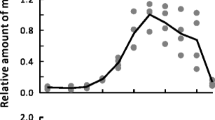Abstract
When pharate adults of the flesh fly Sarcophaga crassipalpis are exposed to 40°C for 4 h they become more tolerant of high temperatures that are normally lethal (thermotolerance). In contrast, a 1-h exposure to 45°C decreases tolerance to a subsequent high temperature challenge (thermosensitivity). While control flies experience little mortality when held at 35°C for 24–48 h the thermosensitized flies die when exposed to 35°C. Sensitivity to a second thermal challenge slowly decays over a 72-h period. The acquisition of thermotolerance prevents the development of thermosensitivity. Brains from thermosensitized flies cultured at 43°C express the 72-kDa heat-shock protein and normal protein synthesis is inhibited. This implies that development of thermosensitivity is not associated with a loss in the capacity to express the 72-kDa heat-shock protein.
Similar content being viewed by others
Abbreviations
- ICN:
-
ICN Biomedicals, Inc. PO Box 19536, Irvine, CA 92713-9921
- LD light:
-
dark cycle
- LT50 :
-
time required to kill 50% of the test animals
- SDS:
-
sodium dodecyl sulfate
- TRIS:
-
Tris(hydroxymethyl)aminomethane
References
Carretero MT, Carmona MJ, Diez JL (1991) Thermotolerance and heat shock proteins in Chironomous. J Insect Physiol 37:239–246
Chen C-P, Lee RE, Denlinger DL (1990) A comparison of the responses of tropical and temperate flies (Diptera: Sarcophagidae) to cold and heat stress. J Comp Physiol B 160:543–547
Chen C-P, Lee RE, Denlinger DL (1991) Cold shock and heat shock: a comparison of the protection generated by brief pretreatment at less severe temperatures. Physiol Entomol 16:19–26
DeLaney JM (1990) A cya deletion mutant of Escherichia coli develops thermotolerance but does not exhibit a heat-shock response. Genet Res 55:1–6
Denlinger DL (1972) Induction and termination of pupal diapause in Sarcophaga (Diptera: Sarcophagidae). Biol Bull 142:11–24
Dikomey E, Eickhoff J, Jung H (1984) Thermotolerance and thermosensitization in CHO and R1H cells: a comparative study. Int J Radiat Biol 46:181–192
Ephrussi B, Beadle GW (1936) A technique for transplantation in Drosophila. Am Nat 70:218–225
Finney DJ (1971) Probit analysis, 3rd edn. Cambridge University Press, Cambridge, UK
Grace TDC (1962) Establishment of four strains of cells from insect tissues grown in vitro. Nature (London) 195:788–789
Hall BG (1983) Yeast thermotolerance does not require protein synthesis J Bacteriol 156:1363–1365
Johnson RN, Kucey BL (1988) Competitive inhibition of hsp70 gene expression causes thermosensitivity. Science 242:1551–1554
Joplin KH, Denlinger DL (1990) Development and tissue specific control of the heat shock induced 70-kDa related proteins in the flesh fly Sarcophaga crassipalpis. J Insect Physiol 36:239–249
Jung H (1982) Interaction of thermotolerance and thermosensitization induced in CHO cells by combined hyperthermic treatment at 40°C and 43°C. Radiat Res 91:433–466
Jung H, Kolling H (1980) Induction of thermotolerance and sensitization in CHO cells by combined hyperthermic treatment at 40°C and 43°C. Eur J Cancer 16:1523–1528
Landry J, Bernier D, Chretien P, Nicole LM, Tanguay RM, Marceau N (1982) Synthesis and degradation of heat shock proteins during development and decay of thermotolerance. Cancer Res 42:2457–2461
Li GC, Werb Z (1982) Correlation between synthesis of heat shock proteins and development of thermotolerance in Chinese hamster fibroblasts. Proc Natl Acad Sci USA 79:3218–3222
Lindquist S (1986) The heat-shock response. Annu Rev Biochem 55:1151–1191
Milkman R (1962) Temperature effects on day old Drosophila pupae. J Gen Physiol 45:777–799
Nielsen OS, Henle KJ, Overgaard J (1982) Arrhenius analysis of survival curves from thermotolerant and step-down heated L1A2 cells in vitro. Radiat Res 91:468–482
Ramsay N (1988) A mutant in a heat shock protein of Escherichia coli continues to show inducible thermotolerance. Mol Gen Genet 211:332–334
Riabowol KT, Mizzen LA, Welch WJ (1988) Heat shock is lethal to fibroblasts microinjected with antibodies against hsp70. Science 242:433–436
Sokal RR, Rohlf FJ (1981) Biometry: the principles and practice of statistics in biological research, 2nd edn. W.H. Freeman, San Francisco
Spiro IJ, Sapareto SA, Raaphorst GP, Dewey WC (1982) The effect of chronic and acute heat conditioning on the development of thermal tolerance. Int J Radiat Oncol Biol Phys 8:53–58
Yocum GD, Denlinger DL (1992) Prolonged thermotolerance in the flesh fly, Sarcophaga crassipalpis, does not require continuous expression or persistence of the 72-kDa heat shock protein. J Insect Physiol 38:603–609
Author information
Authors and Affiliations
Rights and permissions
About this article
Cite this article
Yocum, G.D., Denlinger, D.L. Induction and decay of thermosensitivity in the flesh fly, Sarcophaga crassipalpis . J Comp Physiol B 163, 113–117 (1993). https://doi.org/10.1007/BF00263595
Accepted:
Issue Date:
DOI: https://doi.org/10.1007/BF00263595




